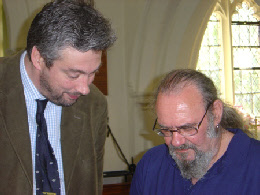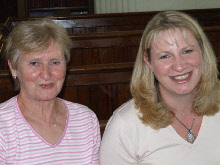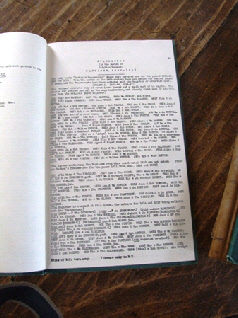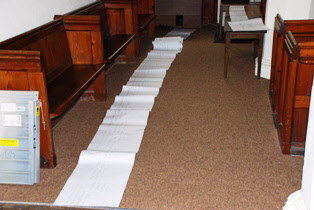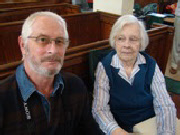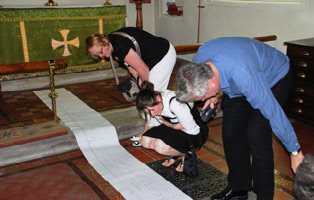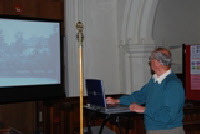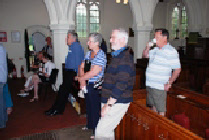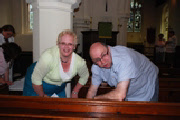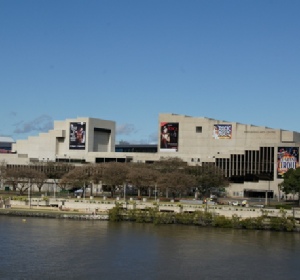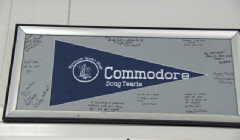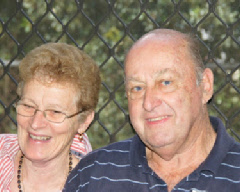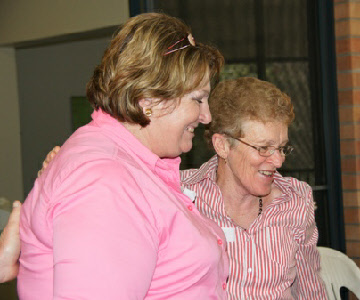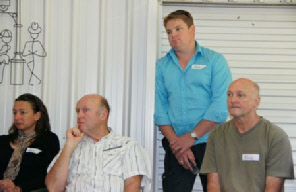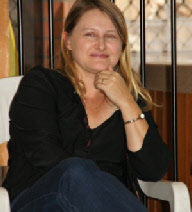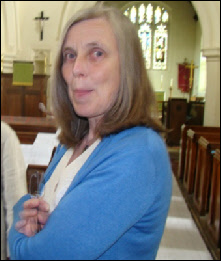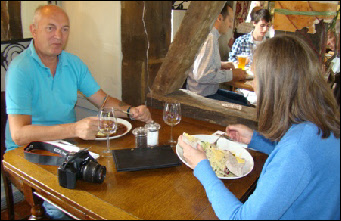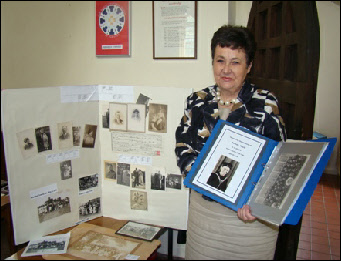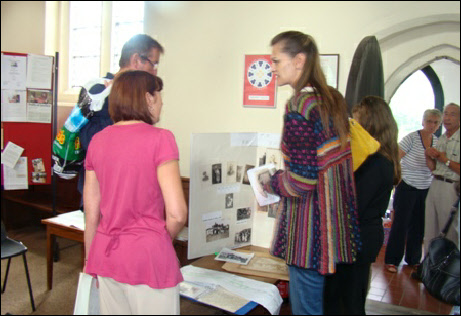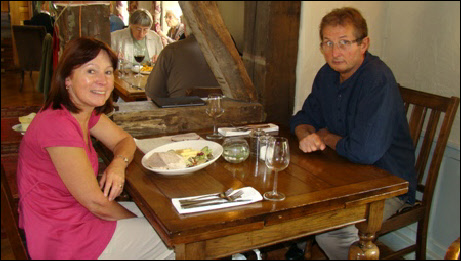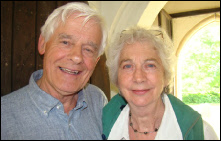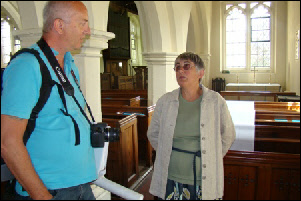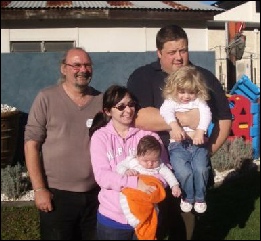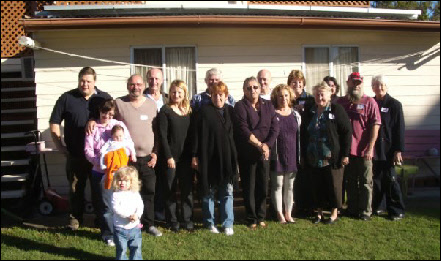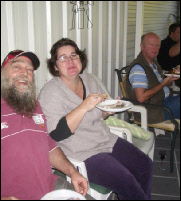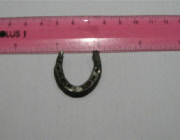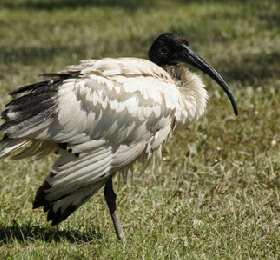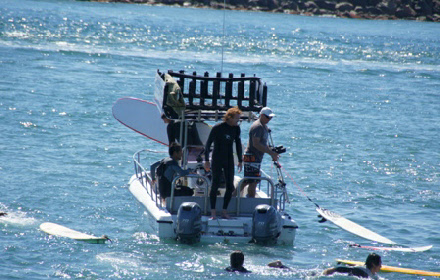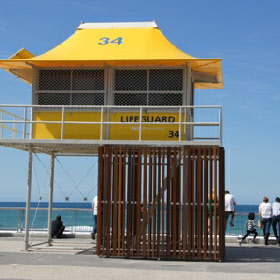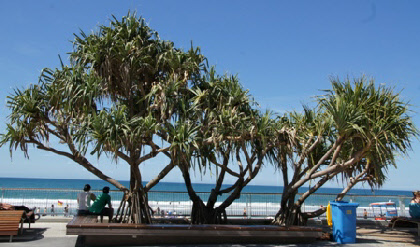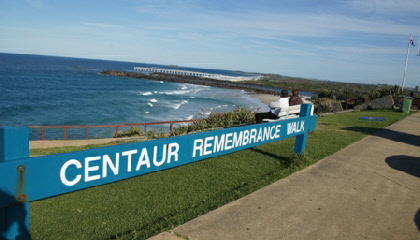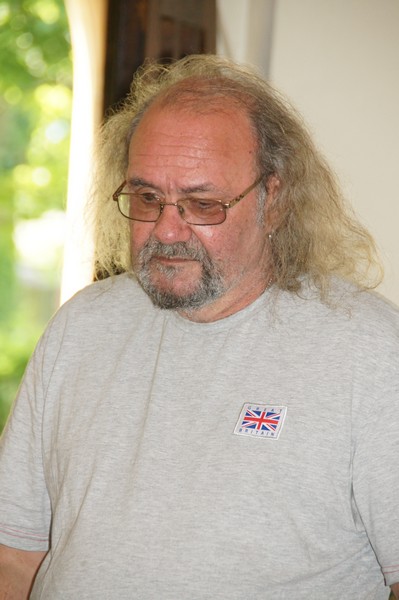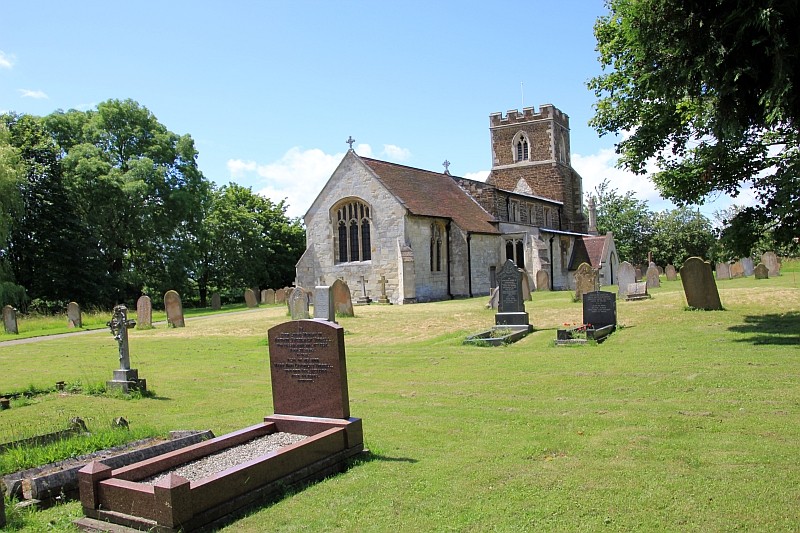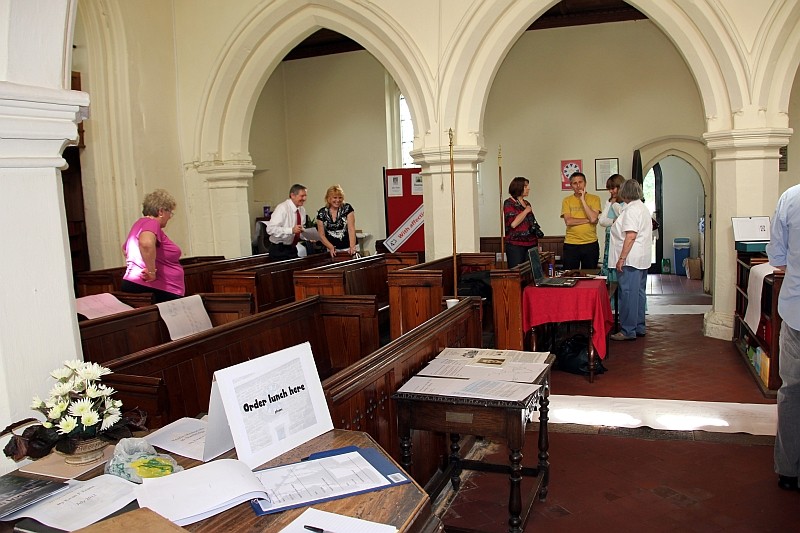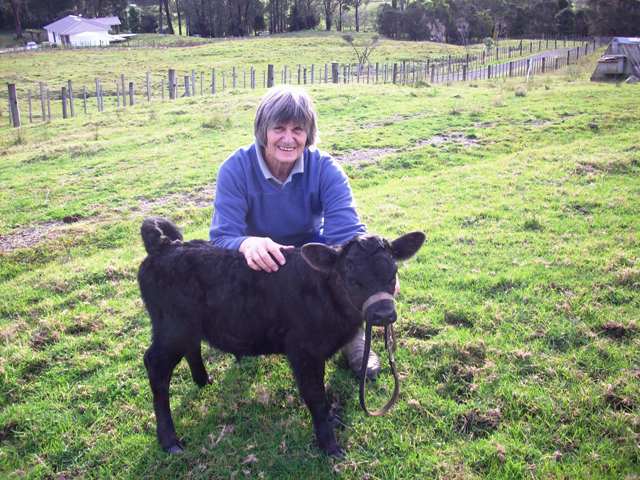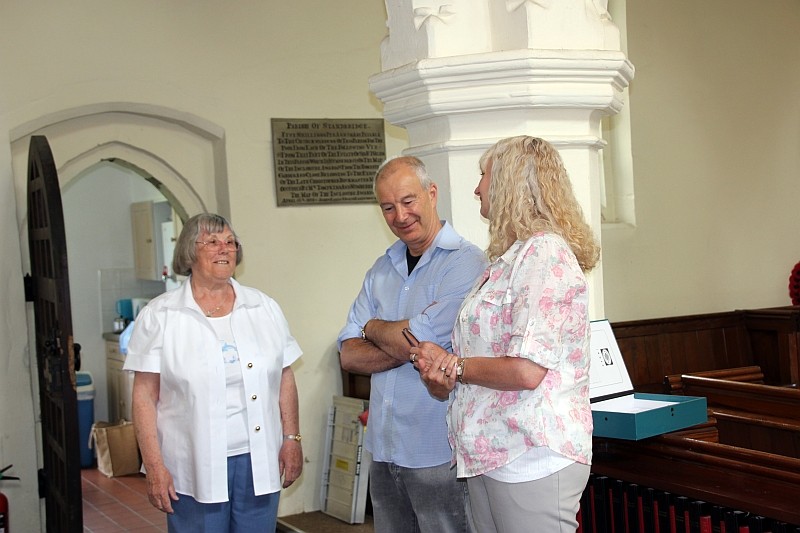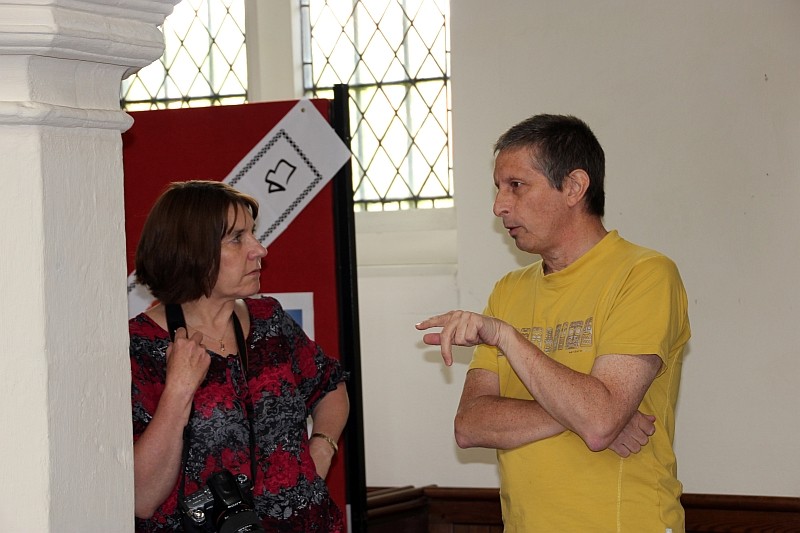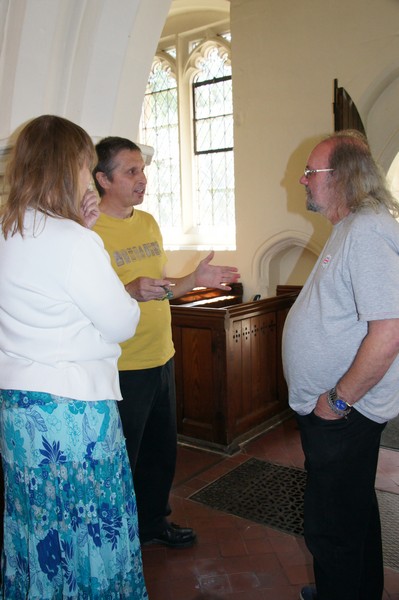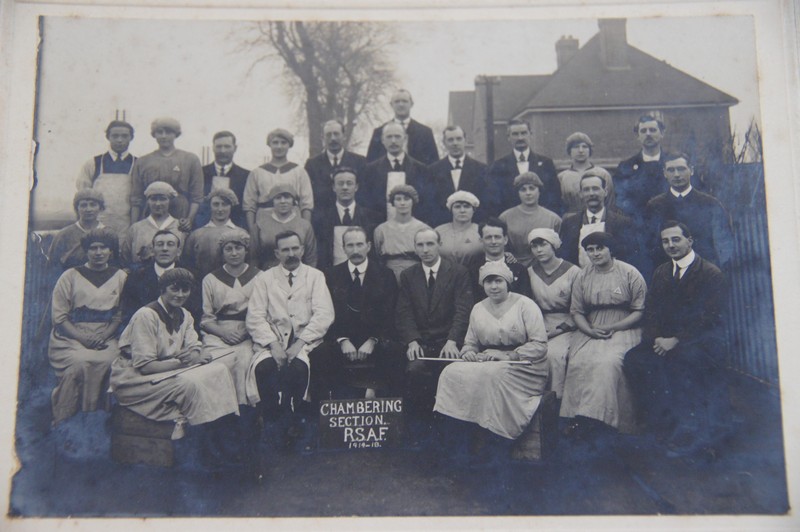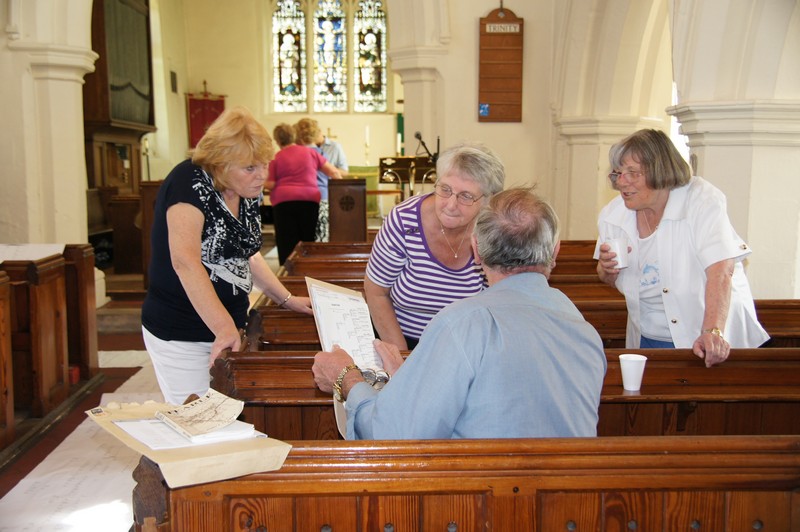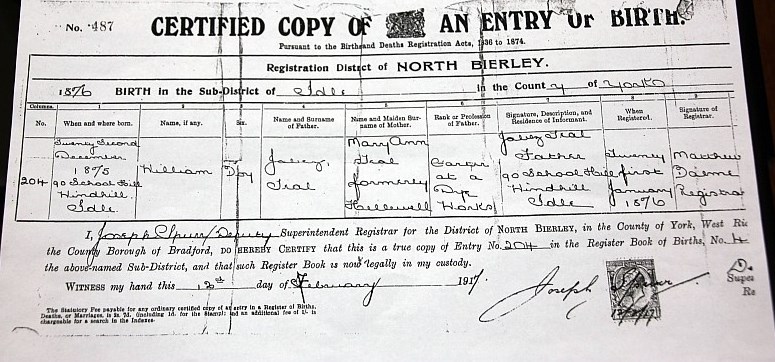The first Tearle meet (inspired by a suggestion from Barbara Tearle) was held at St John the Baptist Church, Stanbridge, Bedfordshire, on 8 July 2006. I hoped about two dozen would attend and we welcomed 50. It was actually a really good number because many people were able to talk to each other and it was a comfortable number to fit in the church. We had people from a very wide area – Rugby, Warwick, Wales, Brighton – so people certainly gave a lot of their time to attend. Many people also brought documents and Jennie Pugh brought some artifacts from my great-grandfather Levi’s smithy in Wing.
As everyone arrived, we gave them a copy of the Tearle Memorials in Stanbridge pamphlet. Here are John and Pat Field, pamphlet in hand, scouting the memorials.
And here’s an idea, below, of just how big the Tree is when printed and glued.
We were very fortunate to have Enid Horton and her daughter Lorinda, below, who volunteered to examine the banns register and transcribe all the Tearle events therein.
We had a visit from the Dagnall Tearles, above, and they lingered long over the John 1741 branch, then went off to Edlesborough to see the memorials there. An engaging group. Front left, Elaine Tearle of Dagnall.
One of our long-term supporters, Jo Smith, was there and she and daughter Tracy, below, met and worked with many of the visitors
A group of us went on an expedition to Wing. Here we are at the cricket grounds inspecting the fencing and the gate that Levi built. I’m the one kneeling. The manager of Ascott House said they might call it Tearle’s Gate.

Front: John and Ewart Tearle and Ingrid Taylor. Behind: David Ashley, Sam Tearle, Barbara Ashley, Jennie Pugh and Barbara Tearle, James and Richard Tearle.
A copy of the typed version of the Bishop’s Transcripts had been given to the church and Rev Janet Spicer left it for us to refer to.
Barbara Tearle, below, is Richard’s sister and a world expert on the Tearles. Here she is on the left, meeting one of the visitors with Elaine in the background talking with Lorinda.
One of the highlights was a visit by a family who hadn’t seen each other for quite a while. Descendants of Mahlon, second son of Levi Tearle of Wing, are John Tearle in the centre, brother to Sheila, while James and Sam are his sons. Jennie Pugh, centre, is their aunt, a grand-daughter to Levi.

John Tearle in the centre, brother to Sheila, while James and Sam are his sons. Jennie Pugh, centre, is their aunt, a grand-daughter to Levi Tearle, blacksmith of Wing.
Richard sent his recollections
A fabulous day that began 24 hours earlier. I travelled down from Lichfield on Friday 7th having booked a room for an overnight stay. The journey was thankfully uneventful and I managed to take in an hour or so in Leighton Buzzard, spending much of that time walking around the graveyard of All Saints Church and then enjoying a much needed mug of coffee in their small cafe.
Then I took the bus to Dunstable, trying to take in every inch of the route. we came upon Stanbridge almost without warning. Suddenly there was a magnificent sign for the 5 Bells and my first fleeting impression was that this was one of the biggest pubs I had ever seen! I barely had time for that thought to register before we were passing the Church of St John the Baptist. And what a beautiful church it looked too. Atop a slight hill and with gravestones on all sides it looked the very epitome of a country church. The bus moved on through Tilsworth and soon we were moving out of the main area we call Tearle Valley: but the signposts all bore familiar names; Houghton Regis, Eggington, Edlesborough, Eaton Bray. I couldn’t help imagining my ancestors walking along these ways or working, perhaps, in some of the fields that flashed by on either side.
On arrival in Dunstable I sought out my accommodation: a little further out than I had imagined, but the Tearle antenna found it without difficulty. I booked in, time to freshen up, unpack, take a rest and appraise the brilliance of Federer and the immense potential of Nadal and then it was out for a pre-arranged dinner appointment with Barbara. Time flew by before we realised that we had spent close on 3 hours indulging in excellent Italian cuisine and recalling family stories, childhood memories and the idiosyncrasies of various relatives from both sides of the family. By the time I got back it was gone eleven o clock and logs could learn a thing or two from me about sleeping!
And then the day dawned…
The sun shone and there was a bit of a breeze which meant that temperatures did not feel too high. Barbara met me where I was staying and within a few minutes Jo and Tracy arrived to pick us up, as had been arranged. Tracy took us through the country side while Jo gave as a fascinating running commentary – neither of us had really been in these parts before. We arrived at the Church bang-on 10.00 and there were already half a dozen or so cars parked on the grass verge.
The first people we met were Pat and John as they arrived at exactly the same time. Ewart was waiting for us all at the entrance to the church, already surrounded by half a dozen earlier arrivals. Ewart then proceeded to hand out the pamphlets he had made up about the Tearle memorials in the graveyard and we set our stuff out on tables for people to look at. Meanwhile, people were pouring into the church – and I am not exaggerating! – and introductions were flying around left, right and centre.
It was heartening and, as Ewart later put it, humbling, to hear the words “I’m not a Tearle but read about today in the Parish Magazine and thought I’d come along as I used to live in the village.” This occurred on a number of occasions. At one stage I counted over 40 people in the church and expectations were exceeded!
Elaine arrived with print outs of the tree and these were laid out on the floor. At times it was impossible to get to them because of the number of people interested. There were a number of old photographs of various family members and one item that was always popular was the Scrapbook that Jo had compiled about old Dunstable.
I am hoping that someone who has a better memory than me can post an account naming people who were there, because I will miss out many and I apologise to them for that.
To give you an idea of how successful it was, Elaine had to go to the 5 Bells to warn them that nearly three times as many people as had been notified to them were intending having lunch there!
I managed to take five minutes to look around the churchyard and meeting up with James and Sam, the sons of John (who had come away from the Llagollen Eistedfodd to attend – serves them right for picking the same day as us!)
All too soon 12:00 arrived and we had to vacate the church. CDs that Ewart had brought along were sold and the money donated to the church. And then most of us repaired to the 5 Bells.
Lunch was a wonderful, relaxed affair. It was very gratifying to see people who had never met before chatting away and making notes of telephone numbers or e-mail addresses. A word should be said about the staff of the 5 Bells: faced with an influx of some 25 Tearles, they organised things magnificently and were friendly and helpful throughout.
Ewart made a short speech, followed by an even shorter one by myself and the day began to wind up, but there was one more treat for some of us. Ewart had arranged that we visit Wing and look at some of the things relating to Levi the Blacksmith. We saw the iron railings and gate that surround the cricket ground at Ascott House and our thanks go to Patrick, the Estate Manager who allowed us to do this, accompanied us and gave us some insight into the stories behind the Rothschilds and life in those times.
Then we went to Wing and looked at Levi’s cottages and the where the smithy had stood. Ewart took us to the Church and we saw Levi’s headstone. At this point, I had to leave and I must thank Elaine for taking the time out to drive me to Leighton Buzzard station.
Special mention must be made of Jennie, Levi’s granddaughter, who was with us the whole day. At 91, I hope I am that sprightly and compos mentis when I get there! She told some wonderful stories of Levi and was clearly moved by the whole event. I would like to nominate Jennie as Guest of Honour and her presence brightened an already brilliant day!
To sum up, then: an unqualified success of great value to all who were there and, I hope, an inspiration to all members. My personal thanks go to Ewart and Elaine whose organisational skills are second to none and to all those who turned up and made it the success it undoubtedly was.
We will be back!
Richard Tearle 09/07/06
Jo sent me her notes on the day’s events:
I have just read Richards account of his day at the meeting, from start to finish, he obviously absorbed every moment from the time he arrived in Leighton Buzzard to the time he got back on the train to Litchfield & it was lovely to read his memories of the day.
I have to say that it was a truly lovely 4 hours for myself & Tracy. Tracy came along but thought she might be bored with all this family chat, but found she enjoyed herself. We were sorry we had to leave early as we would have liked to have gone to Wing, but Tracy had to get back to relieve her partner of the joys of looking after two very energetic boys, one being 3 1/2 & the other nearly two.
I was also pleased to see so many people in the church & also the people who weren’t related but just wanted to join in with us. I would like also to thank Richard, for making the day possible through his web site & to Ewart & Elaine for bringing along the now huge family tree, the CD’s & memorial information. It was also good of the Rev to set out the parish records for us to see.
Hopefully this meeting will be one of many, & we can get to know each other better, but like Richard said we will have to discuss that & see how the membership numbers go. I had the pleasure of sitting next to Jennie in the Restaurant & when she proudly announced to Tracy & I that she was 91 we found it hard to believe as she looks years younger, & she is an inspiration to us all, a very lovely lady.
Here is Barbara’s account:
The TearleMeet 2006
The Tearle family get together, announced in the last issue of the journal, took place on one of those idyllic summer days of sunshine, warmth, and gentle breezes. It was successful beyond the wildest dreams of the organisers. They would have counted it a winner with a dozen people, so they were overwhelmed to find that it had attracted about forty. The day could not be called a Tearle reunion as we had not met before and in fact only a few people had ever met any of the others.
The day was organise by Ewart Tearle, a New Zealander now living in St Albans. It developed naturally from his contribution to the Tearle webgroup run by Richard Tearle. Ewart has been entering everyone’s individual family research on a giant Tearle family tree and touring the area of “Tearle valley” photographing gravestones and the churches of our ancestors, so the obvious next step was to gather the living Tearles together so that we could meet each other.
The TearleMeet attracted Tearles from the south coast and the Midlands as well as from the Leighton Buzzard, Luton and Dunstable area. We met for two hours in Stanbridge church by kind permission of the vicar, who had announced the event in the parish magazine with our invitation to any parishioners who might be interested – and they were! Several Stanbridge ladies told us about the last Tearles in the village, two sisters who were there in the early part of the 20th century. Their deaths ended the family’s association with the village which goes back to 1470 and possibly earlier.
Ewart’s wife Elaine spread the family tree – made up of 60 or more A4 sheets of paper stuck together – along one of the side aisles. Several people brought scrapbooks and photographs. Ewart brought a yoke and a piece of ironwork made by Levi Tearle, a blacksmith in Wing in the late 19th century. Throughout the morning, people were crawling over the tree working out were they were – or rather where their ancestors were because it contains no-one born after 1917. I failed miserably to find Zephaniah Tearle (b. 1868) for one lady who wanted to know where he fitted in, only to be told by Ewart that he was not on the tree as it is not yet clear who his parents were. I had more success tracing the ancestors of the actor Tearles, Sir Godfrey, his brother Malcolm and half brother Conway Tearle, who was not a Tearle at all. Someone else remembered the son of Trelawney Tearle, from the era of the First World War. Lest anyone think that all Tearles have unusual names, most are John, Thomas, Robert, William, George, Jane, Sarah, Mary and Elizabeth, so the different ones stand out as welcome points of reference.
Two hours passed very quickly amidst crawling on the floor, looking at photographs, finding the Tearle graves in the churchyard and the memorial in the church (to the Tearle wife of a Methodist missionary to Africa, both of whom died within months of leaving England) and meeting other people. Many introductions began with the phrase “I’m from the Eaton Bray branch” or the Totternhoe or Luton or Wing branch, meaning that their ancestors moved there from Stanbridge during the 19th century. But no-one was from my branch, the Toddington Tearles.
At noon, we crossed the green to the Five Bells who had been warned during the morning of a group of 25 for lunch. They set aside one end of the restaurant for us to continue chatting and served food and drink with great speed.
Several of us spent the afternoon in Wing viewing the places connected with the blacksmith Levi Tearle, in the company of a delightful lady who admitted to being 91 and remembered living in his house or one of the cottages he built. We were also taken on the Ascott estate to see the iron gate and railings which Levi made and which surround the cricket pitch.
The day brought home to me some of the geographical and social conditions of our Tearle ancestors. For centuries all but a handful of escapees lived in an area radiating for no more than about five or six miles from Stanbridge – but maybe that is the subject of another article.
We all enjoyed the day and hope to repeat it in two years time. It would not have been possible without Ewart’s immense work and enthusiasm and the goodwill of the vicar. The moral of the event for family historian is that an impromptu, low key, gathering is relatively easy to organise and brings a new interest to family history.
Barbara Tearle

